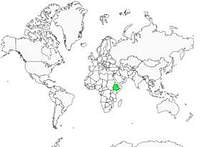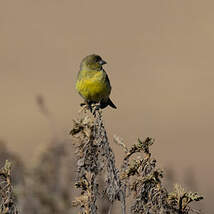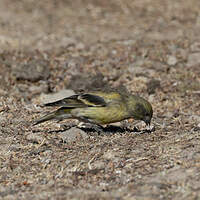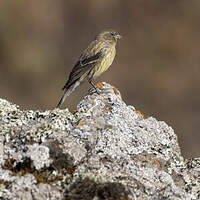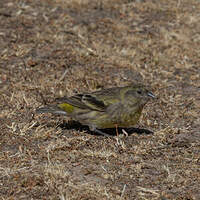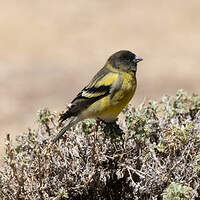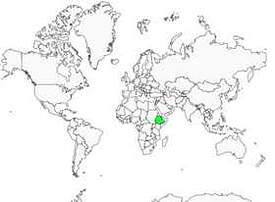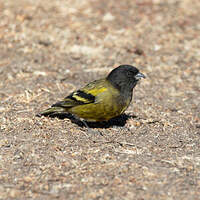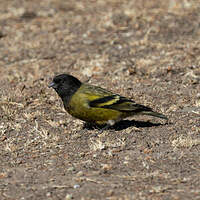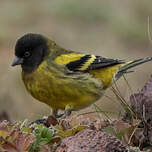Ethiopian Siskin
Serinus nigriceps - Serin à tête noire
Identification
The Ethiopian Siskin is a slim little finch with a fine pointed bill at the end of a serrate tail and long wings, characteristic of altitudinal Ethiopian siskins. The male has an entirely black sooty head from the forehead to the nape and from the chin to the center of the chest, sometimes browner on the ear coverts under good lighting. The iris is dark brown or black, the bill is glossy black. The mantle and the back are dull yellow-olive. The scapulars range from yellowish green to bright yellow, the colors becoming duller in worn plumage. The small coverts are black and the medium coverts are broadly edged in pale lemon yellow. The alula and the large coverts are black, finely edged in pale yellow. The remiges are black with yellow-olive edges. The rump is yellow or yellowish tinged with olive. The tail is blackish finely edged in yellow or chamois white. Seen from the back, the coverts to the tip of the rectrices form a continuity of black and yellow edges. The underside is yellowish tinged with olive green on the sides of the chest and on the flanks. The legs are dark brown. The female has a generally yellow-brown-olive streaked pattern. The forehead to the lores and the contour of the eyes are olive gray. The crown and the upperparts are duller olive green with dark brown streaks except for the rump which is bright yellowish green. The tertiary remiges are black, widely yellow at the tip, the secondaries and primaries are black finely barred with yellow. The underside is yellow, duller than the male, finely streaked with brown from the chin to the flanks. The bill is dark brown, the legs are black. The juvenile is similar to the female but browner on the top. The head is dark olive gray, it has more pronounced streaks on the top and bottom.The edges of the coverings are pale chamois or yellow-chamois which may have dark markings on the upper rump.
Subspecific information monotypic species
Foreign names
- Serin à tête noire,
- Serín cabecinegro,
- canário-etíope,
- Schwarzkopfgirlitz,
- feketefejű csicsörke,
- Zwartkopkanarie,
- Lucarino d'Abissinia,
- etiopisk siska,
- Svarthetteirisk,
- kanárik čiernohlavý,
- zvonohlík černohlavý,
- Etiopersisken,
- eritreanhemppo,
- gafarró capnegre,
- kulczyk czarnogłowy,
- Черноголовый канареечный вьюрок,
- ズキンヒワ,
- 埃塞俄比亚丝雀,
- etiopiensiska,
- 阿比西尼亞黑頭絲雀,
Voice song and call
The Ethiopian Siskin generally perches atop a shrub, quite high or at the top of a grass stem to sing. Occasionally on a power line at the side of the road. The song is a pleasant musical phrase series with frequent trills that echoes the song of the Common Chaffinch but without buzzing notes or phrases. It also includes a wide variety of loud chattering and twittering with a short, sharp trrrrr and a chit-chit-chit.
Habitat
The Ethiopian Siskin is endemic to a small area of Ethiopia, where it resides and breeds in mountain forests and open moorland often consisting of giant heather, alchemilla, St. John's Wort, thickets of euphorbias and giant lobelia, an endemic species of the Simien National Park. It can also be found on the edges of cultivated land and around villages.
Behaviour character trait
The Ethiopian Siskin is a sedentary and gregarious species that lives throughout the year in its high altitude habitat.
The only movements are very short displacements to lower levels in case of bad weather. The Ethiopian Siskin lives and feeds in small groups composed of males and females, the group usually does not exceed 10 individuals, but larger flocks of up to 100 individuals can be observed more rarely. These small groups of individuals are quite active and often fly during the day to search for their food either on the ground, in the middle of thickets and low shrubs or perched on tall grasses. The attitudes and posture that the Ethiopian Siskin adopts, particularly during singing, would rather make us think of a Eurasian Siskin or a Melodious Linnet. The species is monogamous.Flight
Dietfeeding habits
The Ethiopian Siskin is a granivorous bird. Its main diet consists of seeds from plants and trees, including the ones from St. John's wort and larger trees such as Hagenia abyssinica. It looks for its food on the floor, clinging to the vegetation and fine grass stems to directly consume the seeds.
Reproduction nesting
Gregarious species, the Ethiopian Siskin becomes territorial when breeding season arrives. The pair nests alone and remains united for life.
Breeding takes place twice a year, in May-June and then from August to October. The female builds her nest in low vegetation, at a height lower than 1 metre. She can choose to hang her nest on a thistle, in the middle of a spurge, inside a bush or on an outer branch of a shrub. Exceptionally, as it was the case in the Balé Mountains for two nests, it can be situated between 1 metre and 1.5 metres. These cases are nonetheless very rare. The nest is a compact cup made of fine grasses, rootlets and lined with vegetable down and feathers. The female lays 2 or 3 whitish-blue eggs, finely speckled with brown which she incubates for 14 days. The chicks leave the nest after 17-18 days.Geographic range
Threats - protection
Sources of information
- IOC World Bird List (v14.2), Gill, F and D Donsker (Eds). 2024-04-18.
- Finches and Sparrows, Peter Clement
- Birds of the Horn of Africa, Nigel Redman
- Where to Watch Birds in Ethiopia, Claire Spottiswoode, Merid Gabremichael, Julian Francis
- Birds of the World, The Cornell Lab of Ornithology
- eBird, Cornell Lab of Ornithology et National Audubon Society
Other sources of interest
 Specification sheet created on
16/07/2023 by Nathalie Santa Maria
Specification sheet created on
16/07/2023 by Nathalie Santa MariaTranslation by AI Oiseaux.net
© 1996-2025 Oiseaux.net
- Accipitriformes
- Aegotheliformes
- Anseriformes
- Apodiformes
- Apterygiformes
- Bucerotiformes
- Caprimulgiformes
- Cariamiformes
- Casuariiformes
- Charadriiformes
- Ciconiiformes
- Coliiformes
- Columbiformes
- Coraciiformes
- Cuculiformes
- Eurypygiformes
- Falconiformes
- Galliformes
- Gaviiformes
- Gruiformes
- Leptosomiformes
- Mesitornithiformes
- Musophagiformes
- Nyctibiiformes
- Opisthocomiformes
- Otidiformes
- Passeriformes
- Pelecaniformes
- Phaethontiformes
- Phoenicopteriformes
- Piciformes
- Podargiformes
- Podicipediformes
- Procellariiformes
- Psittaciformes
- Pterocliformes
- Rheiformes
- Sphenisciformes
- Steatornithiformes
- Strigiformes
- Struthioniformes
- Suliformes
- Tinamiformes
- Trogoniformes


